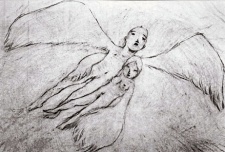
Watching A Feather Stare at the Dark, it feels as if the charcoal anime medium was meant to inevitably produce such a work. Here is a short surrealist film centered around a journey to an unfamiliar land, polarized by good and evil, driven entirely through action and movement without any diegetic sounds. Certainly this animation style, relatively unexplored and outlandish, does a good job of pulling us into this parallel world and leaving us puzzled, with a black and white palate as polarized as the characters themselves. The soundtrack, an abstract but in no way atonal series of bass lines, loftily pull us through this adventure and serve as the sole audio component, with each successive note standing alone like the clearly discrete drawings strung together to make the pictures move.
Every piece of this work seems intentionally designed to engage us not just with the story within the work, but with the technical details by which it was produced, forcing us to understand the chaos and surrealism on a meta-contextual level. Director Tsuji Naoyuki claims to have left the progressions of the scene somewhat to chance, drawing movement in whatever fashion he saw fit. And indeed what sticks out most about this work is the extraneous details and motions that worked their way in, despite the need to draw every frame sequentially without cutting corners. Seeing interactions like a pair of nameless people bumping into one another in the background or the wind blowing through a girl’s hair gave it a life that feels to run almost counter to the surrealism and striking medium at play.
And surrealist elements there certainly are, following a young love-child of the gods as he searches for the woman borne of his left hand, stumbling into a hostile world of angels and demons, and in cutting off his father’s wing as a warped act of revenge he inadvertently causes the apocalypse. The imagery is softened by the background bass lines and by the smudged charcoal constantly left behind by past scenes, but even so it is wrapped up in sexual and unsettling shots such as a god producing an endless city through an agony-inducing ejaculation caused by a demon, or a sinister bird coming through a window to assault the young woman asleep within. A particular shot stands out: the opening scene, mirrored twice more throughout the work, shows the young protagonist walking towards a far-away volcano, a shot using the typical trick of having him remain the same size while the volcano changes as he approaches. Yet because of the charcoal medium, this trick is plainly shown on the page, resisting any illusions of him being the moving entity as the volcano visibly grows and leaves traces of its former self, the boy simply leaving smudges next to his legs both in front of and behind him. Furthermore the volcano, rather than growing in size the closer he gets, shrinks, an unrealistic perspective shot that also casts the volcano as being little more than a toy model.
Yet perhaps unlike pure surrealism, this work does not completely resist interpretation. White and black are the only two colors besides the smudged grey left behind, and yet neither correspond directly to the morality at play. The final scene has all the forces of good and evil sitting around a table eating a cordial dinner, and only by the rest of the work do we have any way to discern which is which. The loving tender sexual intercourse between the boy’s parents in the opening scene belies his father’s ambiguous moral situation throughout the rest of the work, assaulted by evil but also clearly on the wrong side of the world’s stability. The journey, while random and haphazard, is linear in nature, with the boy performing a fairly natural approach to exploration even as chaos ensues around him. There is clear purpose, motive, and causality.
Who would enjoy A Feather Stare at the Dark? I hazard to say it's not the anime viewers, as the two are similar only in that they are animation. The artists will thoroughly enjoy the intersection of the bold artistic medium of charcoal and the audiovisual format of film, particularly in how well the content and our perception of it is so blatantly tied in with this choice of medium itself. That the work is philosophical, moral, and skates the line between meaning and disorder probably gives the scholars and philosophers something to grab hold of as well. And though much of its imagery may be alienating, the bolder and more adventurous anime viewer will have little reason to not enjoy its neat 17 minute package. The target audience is small, but what it does it does exceptionally well.